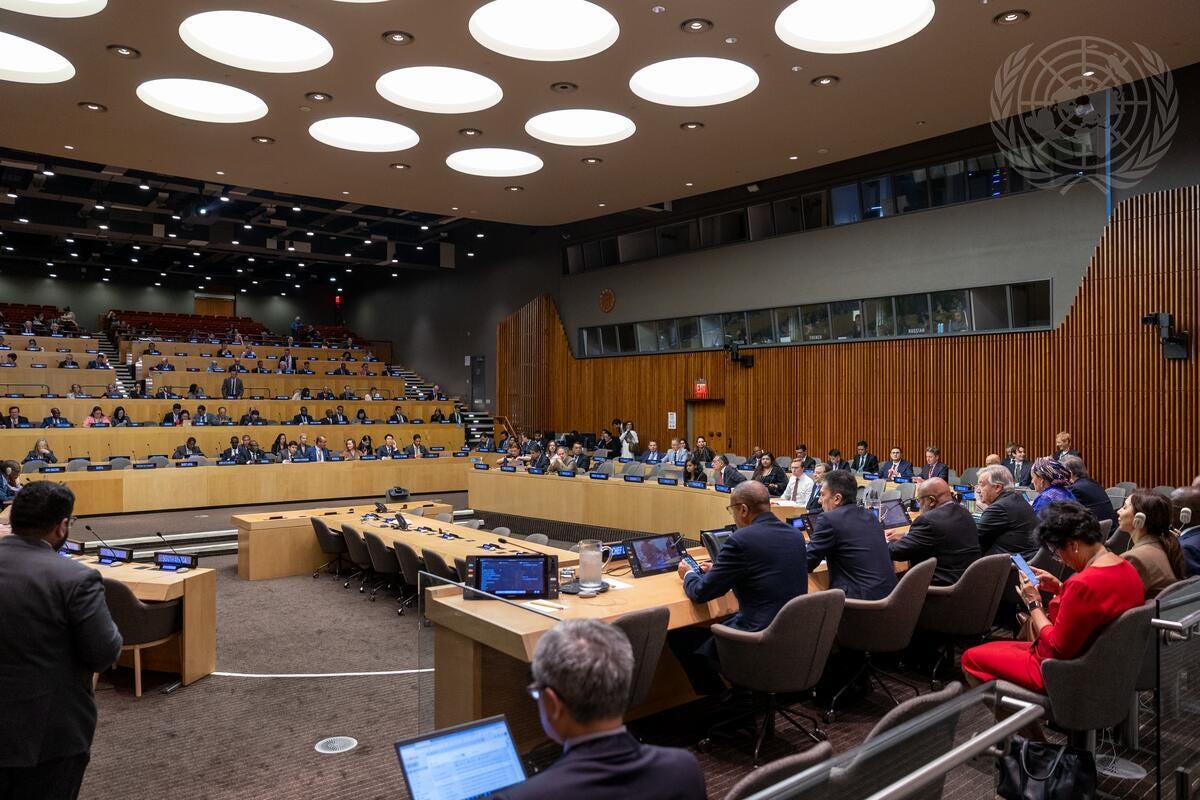Global Shield Newsletter (25 October 2023)
Summit of the Future, WMD risk and uncertainty, and regional conflicts
This twice-monthly newsletter highlights the latest policy, research and news on global catastrophic risk (GCR).
This edition showcases how the global level interacts with the regional, bilateral and local levels. The UN Summit of the Future, locked in for September 2024, will bring together world leaders to discuss, well, the future. It’ll help show how the sustainable development goals and global catastrophic risk are inextricably linked. The risk arising from major powers’ weapons programs is increasing. The rest of the world bears both the risk and the uncertainty. Meanwhile, regional conflicts are raging. How they shape GCR remains unclear – all the more reason they require attention.
Capitalizing on the Summit of the Future

The Summit of the Future, a high-level UN event arising out of Secretary-General António Guterres’ Our Common Agenda, is less than a year away. The Permanent Representatives of Germany and the Republic of Namibia have been designated as co-facilitators for the intergovernmental preparatory process. A key outcome will be “A Pact for the Future”, which will cover sustainable development and financing for development, international peace and security, digital cooperation, youth and future generations, and transforming global governance.
Policy Comment: The Summit of the Future could be a landmark multilateral meeting for global catastrophic risk. The focus of the summit is likely to be advancing the sustainable development goals, reforming international finance and improving the global governance and multilateral system. It will also provide opportunities to directly address GCR and indirectly bring attention to it. The most direct support for GCR is the proposal around an Emergency Platform, which would strengthen international responses to complex global shocks. The declaration for future generations could enable greater consideration of GCR within the UN system.
Reducing global catastrophic risk is important for the sustainable development goals. Severe global shocks will take a disproportionate toll on low-and-middle-income countries. Major global priorities – reducing inequality and poverty, expanding human rights, alleviating food and water insecurity, and tackling climate change – are inextricably linked to GCR. Efforts that improve both together could be prioritized. For example, during the Summit of the Future, member states may wish to consider ways to improve resilience of food systems, reduce how emerging technologies exacerbate conflict, and increase preparedness and response capabilities to disasters and catastrophes. Reaching the SDGs requires a future secure from GCR.
See also:
Recent reporting on the SDG Summit (the major UN summit held in September) and the Ministerial Meeting that set out the priorities for the Summit of the Future, as well as a useful briefing on the path to the summit.
Reducing risk by reducing uncertainty

A number of recent policy announcements and strategic assessments demonstrates the continued increase of risk from weapons of mass destruction. The US Department of Defense released the 2023 Strategy for Countering Weapons of Mass Destruction, the first in almost a decade. It notes that “new technologies, such as big data, artificial intelligence, and genomic modification, have the potential to significantly influence the CBRN [Chemical, Biological, Radiological, Nuclear] environment.”
The DoD has released its 2023 China Military Power Report, an annual report to Congress on military and security developments in China. The DoD assessed that China has about 500 operational nuclear warheads, and that it will “probably have over 1,000 operational nuclear warheads by 2030, much of which will be deployed at higher readiness levels.” It also assessed that “the PRC’s chemical and biotechnology infrastructures are sufficient to research, develop, and produce some chemical and biological agents or toxins on a large scale.”
On 12 October, the Congressionally-mandated Strategic Posture Commission released its report on US nuclear policy and force posture. It found that the US is unprepared for the looming two nuclear-peer threat environment and calls for a nuclear build-up across all domains. The Federation of American Scientists argued that “the recommendations included in the Commission report are likely to exacerbate the arms race, further constrict the window for engaging with Russia and China on arms control, and redirect funding away from more proximate priorities”. Founders Pledge assessed that it “essentially, call[s] for a new nuclear arms race with Russia and China.”
The National Academies of Sciences has published a report on Risk Analysis Methods for Nuclear War and Nuclear Terrorism, which highlights the strengths and weaknesses of risk assessment approaches. A key conclusion was that “there is a need to improve the understanding of less-well understood physical effects of nuclear weapons (such as fires; damage in modern urban environments; electromagnetic pulse effects; and climatic effects, such as nuclear winter), as well as the assessment and estimation of psychological, societal, and political consequences of nuclear weapons use.”
Policy comment: The risk from catastrophe weapons is increasing. Making matters worse, interactions with other factors – geopolitical competition, terrorism and extremism, cyber and space infrastructure, emerging technologies and fragility of critical civilian infrastructure – increases the uncertainty surrounding these weapons’ development, use and impact. Reducing weapons-related risk requires more than reducing the weapons themselves. It requires dealing with these factors.
Major powers should take actions that not only reduce risk but also reduce uncertainty. This might include more strategic warning protocols across a range of GCR scenarios, comprehensive de-escalation and crisis strategies, clear doctrine and preparedness around attacks on critical infrastructure, bilateral or multilateral crisis hotlines, and multi-pronged forms of diplomatic engagement, including track 1.5/2 dialogues. Using catastrophe weapons should become inconceivable.
See also:
The Stanley Centre for Peace and Security has released a new report that reviews the history and performance of nuclear risk reduction centers (NRRC) in the US and Russia and presents ideas for expanding on the NRRC concept to enhance risk reduction.
RAND has a new Perspective on determining "how much is enough" for US nuclear forces in the emerging strategic environment.
Perry World House hosted a number of nuclear risk discussion panels at the Global Order Colloquium. The discussions focused on managing nuclear risk amid other global challenges, including geopolitical tension, climate change, international conflict and technological development.
See our assessment on nuclear risk in our 8 August newsletter.
Mitigating regional conflicts, not just global wars

The Israel-Hamas conflict is at risk of spiralling into a regional conflagration. US troops were attacked by Syrian militant groups using drones. Meanwhile, Ukraine has equipped autonomous weapons with AI to find and attack targets, and “Ukraine and Russia are girding for a winter of intense fighting,” according to Bloomberg. Azerbaijan has taken control over Nagorno-Karabakh, an ethnically Armenian enclave. The risk of the conflict extending has not dissipated, after the entire population of 120,000 Armenians fled west. Turning to the latest conflict in Sudan, which has lasted six months, the UN estimates that 9,000 people have been killed and another 5.6 million have fled. The US State Department has called for the Rapid Support Forces to stop its intensified shelling of civilian neighborhoods in Sudan.
Policy comment: Conflict of a globally catastrophic level is mostly seen through the lens of nuclear weapons, particularly in the context of the strategic rivalry between the US, China and Russia. However, local or regional conflict and instability should not be dismissed from a GCR perspective. These conflicts become testing ground for new capabilities; AI-enabled weapons systems are being increasingly deployed, for example. They can also create escalation potential that might bring the great powers in contest, at least diplomatically, and, potentially, militarily. Indeed, two participants in these various conflicts – Israel and Russia – are nuclear weapons states.
Furthermore, these conflicts are a humanitarian crisis, drawing in resources and capacity from an already stretched web of diplomatic corps, multilateral agencies and civil society groups. These resources and attention are diverted from preventing and preparing for other catastrophic threats. The types of policies needed to reduce the risk of regional conflicts are likely to be applicable for GCR-level scenarios. GCR policy researchers, advocates and practitioners would be wise to not ignore regional conflicts and their secondary and tertiary effects on GCR.
See also:
A number of organizations track global conflicts, including CFR’s Conflict Tracker, the International Crisis Group’s Crisiswatch and the Early Warning & Forecasting Hub of the Armed Conflict Location & Event Data Project (ACLED).

